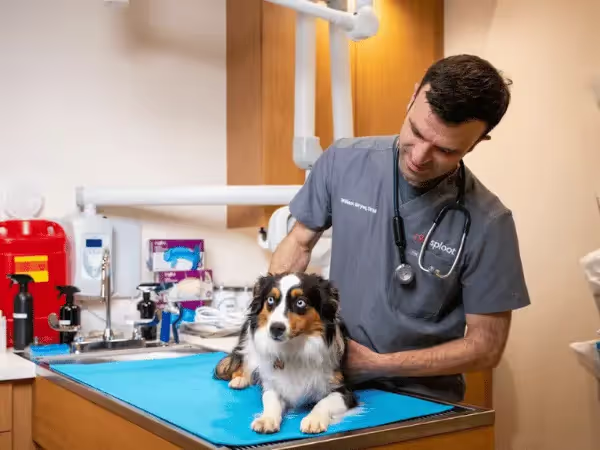You may be having a wonderful time outdoors with your pup and then out of nowhere, your fur baby gets stung by a bee. At Sploot, we get several calls a day from pet parents asking “What do I do if my dog gets stung by a bee?” or “Is a dog bee sting an emergency?”, especially during seasons with plenty of outdoor activities.
Read on for more information on dog bee stings, first aid tips, and when to seek veterinary care.

Dog Got Stung by a Bee: Signs & Symptoms
Whether or not you witnessed the bee sting yourself and identified the insect, there are some tell-tale signs that you can look out for.
Dog bee sting symptoms can appear as early as 20-30 minutes after the stinging took place — or up to a few hours after the incident.
A. Mild to Moderate Symptoms of Dog Bee Sting
Here are a few mild to moderate reactions to look out for after your dog gets stung by a bee.
- Whining, licking the site of the sting (behavioral signs of pain in dogs);
- Holding up their paw (common if the leg or paw was stung);
- Itchiness, swelling, and redness on the site of the sting;
- Hives, an allergic reaction that produces raised welts or bumps on the skin — though this is not an emergency symptom by itself, it is a sign that your dog is allergic to bees and should be monitored closely.
B. When Is a Dog’s Bee Sting an Emergency?
Additional symptoms from your dog getting stung by a bee may require emergency care, such as the following scenarios:
1. Anaphylactic Shock Due to a Dog’s Bee Sting
A dog’s bee sting could potentially trigger an allergic reaction. Though rare, these can escalate into anaphylaxis, a severe and life-threatening allergic reaction, characterized by the following symptoms:
- Facial swelling;
- Drooling;
- Difficulty breathing;
- A pale or bluish color of the gums and tongue;
- Vomiting and diarrhea; and
- Collapse.
Note: Contact a vet immediately and seek emergency care if you notice these symptoms; these can progress within minutes in susceptible pups
2. Dog Stung By a Bee on the Head, Mouth, or Nose
In some cases, facial swelling is not exclusively because of anaphylaxis; this can also happen because the dog was stung on the head, nose, or mouth. If this is the case, the situation can still become a veterinary emergency if the swelling obstructs the dog’s breathing.

What Do I Do If My Dog Gets Stung by a Bee? (H-E-A-L)
We'd like to start by reminding pet parents that while this guide includes many helpful first-aid tips for cases wherein a dog is stung by a bee, the most critical steps can be summarized with an acronym or mnemonic device we've prepared: H-E-A-L, which stands for:
- Head to safety.
- Extract the stinger.
- Alert your vet.
- Look out for emergency symptoms.
In the following sections, we go over the above vital steps, their importance, and other useful first-aid tips that can help with managing bee sting symptoms in dogs:
1. Head to Somewhere Safe with Your Pup
After a bee sting, they release chemicals that could potentially attract more bees. The same phenomenon applies to other stinging insects (i.e. wasps and hornets).
Therefore, the first step after your dog gets stung by a bee (or by other stinging insects) is to head for safety. Make sure that you and your pup are a safe distance away from where the incident took place.
Note: This safe place should only be a minute or so away because mild to moderate symptoms can appear as early as 20-30 minutes after the dog’s bee sting. Signs of anaphylaxis, though rare, can also show up within the first 5 minutes.
2. Ready Your Dog First Aid Kit
You will need a few items from your dog’s first aid kit, such as the following:
- Tweezers
- Ice pack
- Benadryl or diphenhydramine (strictly to be used under veterinary guidance)
3. Extract the Stinger/s
Use tweezers from your dog's first aid kit to remove the stinger, or stingers if multiple, from your pup. A prompt removal of the stinger after your dog was stung by a bee helps reduce the amount of venom pumped through the stinger, thus helping avoid more severe reactions.
Note: Can’t find the stinger? It’s possible that your dog was stung by another stinging insect, like wasps or hornets, which do not lose their stingers. Like bees, though, these insects also have venom. However, the most dangerous of the three is bee venom — even though wasp and hornet stings can cause more pain. If you are unsure which stinging insect has dealt the sting, following these first aid steps is advised.
Important Note: If you’ve observed emergency symptoms of your dog’s bee sting, simply get to safety, remove the stinger, and promptly call a vet. Only continue with first aid after this point IF anaphylaxis (facial swelling, vomiting, diarrhea, collapse) and obstructed breathing are NOT observed.
4. Apply an Ice Pack to Help Reduce Swelling
Apply an ice pack to the area where your dog was stung. This will limit blood flow to the area, thus helping reduce swelling and pain. The ice pack will need to be applied for at least 10 minutes.
While doing this, you can contact your veterinarian to discuss the next steps and recommendations for your pup’s treatment.
5. Contact The Vet
Contact a veterinarian, preferably an urgent or emergency care vet. You can also try contacting an all-around vet care provider like Sploot with primary, urgent, and emergency vet services under one roof. Dog bee stings can become urgent or emergency care situations. Having one point of contact can save valuable time.
→ Need our help? We offer emergency vet services in Denver and Chicago. If your pet is showing emergency symptoms, give our team a call.

6. Apply a Baking Soda & Water Paste *OPTIONAL FIRST AID*
If you happen to have baking soda and water available, prepare a paste and put it over the site of the dog bee sting. Using baking soda after a dog is stung by a bee can help neutralize the acidity of the bee’s venom, while also helping relieve itching and reduce swelling.
Should I Give My Dog Anything for a Bee Sting?
While getting in touch with a vet, you can offer your pup fresh water and/or administer diphenhydramine or Benadryl — STRICTLY IF the veterinarian you contacted recommends it. You will also be instructed on preparing a safe dose for your dog if needed.
Note: Administering a safe dose is crucial; diphenhydramine overdose in pups can produce potentially life-threatening side effects. Please make sure to use this medication with caution and only under vet guidance.
How Long Do I Monitor a Dog After a Bee Sting?
Your veterinarian will advise you whether you need to bring your dog to the vet clinic or if you can continue with home care. Whether you stay at home or return home after going to the clinic, you’d likely be recommended to monitor your pup for the next few hours.
Be Extra Prepared for Pet Emergencies & Boost Your Pet’s Health with SplootPack™
Save hundreds on vet care, plus get added peace of mind for your pet’s illnesses & emergencies. The SplootPack™ membership helps you save up to $600+ on essential veterinary care.
This membership offers benefits for not only health-boosting preventive care but also life-saving urgent care and emergency vet services at Sploot!
Get 3 waived wellness exams or check-ups, 10% OFF on all Sploot’s services, exclusive discounts, and more!
- Learn more - SplootPack™ Denver →
- Learn more - SplootPack™ Chicago →
Sploot Vets: Your Go-To Vet for Primary, Urgent, & Emergency Vet Services
If you have further questions or concerns about your pet’s health, we are here to help. Sploot Veterinary Care is a vet care provider in Denver, Chicago and Colorado Springs, offering next-level vet care.
We offer daily appointment availability, including holidays and weekends, with extended clinic hours. We offer scheduled vet appointments, same-day vet visits, and urgent drop-off appointments.
Easily book an appointment online or through the Sploot Vets app. As for urgent or emergency vet services, call our team at (720) 770-8656.
Till next time, we’re with you every pounce of the way!






